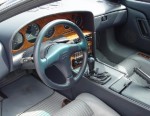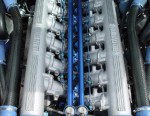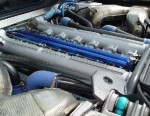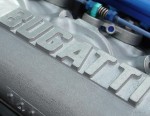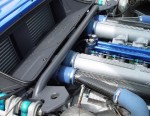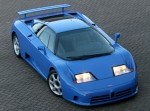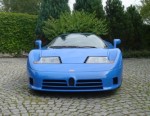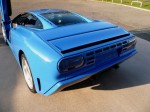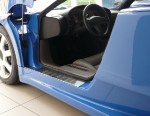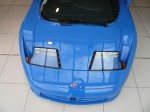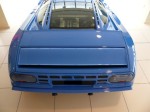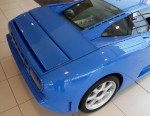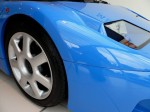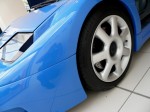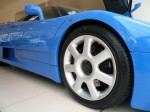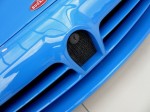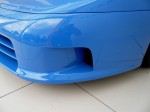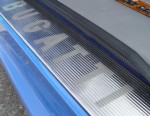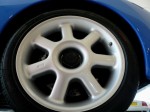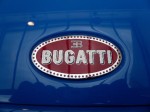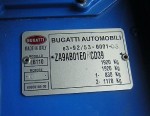Bugatti EB 110 GT
- 1994
- 18.000 km
- Original
- EU title
- EU taxes paid
- Sold
When Ettore Bugatti died in 1947, the Bugatti Company ceased production. The long, historic, and prestigious lineage of the famous Bugatti Company was no more. That is until 1989 when an Italian entrepreneur named Romano Artioli purchased the rights to the Bugatti name and began automobile production in an area north of Modena, Italy.
To honor Ettore Bugatti, the EB 110 was created. EB was short for Ettore Bugatti. Launched on Ettore's 110 birthday, 15.09.1991, the naming EB 110 was formed. It was first shown to the public at the Grande Arche at La Défense in Paris, France.
The powerplant is one of the most advanced and complex engines ever created while the chassis and design is just as superb. Marcello Gandini of Bertone was tasked with creating a unique and stylish body that would be a modernized tribute to the glorious designs of the past. The result was an aerodynamic masterpiece with a horse-shoe shaped grille and an aluminum body. Aluminum was chosen because of its lightweight but sturdy characteristics. Aerospatiale, a French aviation company, was commissioned to aide in the production of the body, due to the metals being difficult to shape. The body panels were bonded to the carbon fibre monocoque chassis, one of the first road going vehicles to use this design and technique. In the front were push-rod operated shock absorbers while the rear featured dual shock absorbers on each side.
Mounted mid-ship was a 60-degree 3.5-liter V12 with dual overhead camshafts and producing an impressive 560 horsepower. Four IHI turbochargers aided the engine in producing its impressive power. This power was sent to all four wheels, 73% going to the rear, with the help of a six-speed manual gearbox. Zero-to-sixty was accomplished in about 3.6 seconds while top speed was achieved at 209 mph. Ventilated Brembo disc brakes brought this monster to a stop.
The scissor doors were truly exotic. The engine was visible through a glass cover, and the rear wing was speed sensitive. Five pre-production prototypes with aluminum chassis were constructed, followed by eight made out off composite.
If this wasn't enough, an EB 110 SS version, meaning Super Sport or Sport Stradale, was created. The interior was void of an unnecessary amenities and luxurious. In total, more than 150 kg was stripped from the vehicle. The four-wheel drive system could be replaced with a lighter, rear-wheel drive configuration, decreasing the weight even further. The turbo boost was increased and the compression was dropped to 7.5:1, resulting in a rise in horsepower to around 620. Further modifications set the horsepower rating to as high as 660. Air holes located behind the side windows and seven spoke alloy wheels helped distinguish the standard GT car from the SS.
The Bugatti EB 110 SS made an appearance at the 1994 24 Hours of LeMans race. This was their first appearance in 55 years. Positioned in the GT1 class, vehicles with horsepower up to 600, the Bugatti was the fastest during training, outperforming the Dodge Vipers, Porsche Carrera RSR's, DeTomaso Pantera's, and the rest of the competition.
Right before the race, a fuel leak was discovered. Araldite was used to seal the leak but it meant that the Bugatti had to use a half tank of gas for the first couple of shifts. After the Araldite dried, a full amount of fuel could be used. The Bugatti quickly showed its potential, cracking the top-ten. A problem with the turbochargers sent the team scrambling to replace them. The problem was fixed and the Bugatti was back on the track. Near the close of the race a tire failure sent the Bugatti into the barriers and the EB 110 SS was forced to retire.
Since that time, the EB 110 SS has raced at Watkins Glen, Daytona 24 Hours, and other races. Gildo Pallanca-Pastor drove an EB 110 SS on the frozen sea in Oulu in Finland, in 1995, capturing the World Speed Record on ice with a speed of 296.3 km/h.
Produced from 1991 through 1995, only 95 GT's and 31 SS's were produced. One of the SS's was purchased by Michael Schumacher. It is unfortunate that the EB 110 was introduced just when the supercar market crashed. The Bugatti Company was forced to file for bankruptcy while the remaining materials were sold to B Engineering and used for the use of their sports car, the Edonis.
“ your classic auto specialist; world-wide collector car expertise ”
We buy, sell, broker, locate, consign and appraise exceptional classic, sports and collector automobiles, arrange transport, customs formalities and registration.
Jaguar, Ferrari and Maserati expertise, though our collection includes a wide variety of other superior antique, vintage, prewar and race cars.
Contact us when you are serious about owning or selling a fine classic motor car or motorcycle. Geneva, Switzerland-based, we serve clients world-wide.
Chemin des Tulipiers | 1208 | Geneva | Switzerland | +41 (0) 787.055.745
